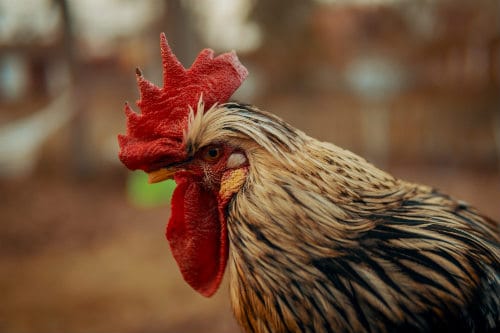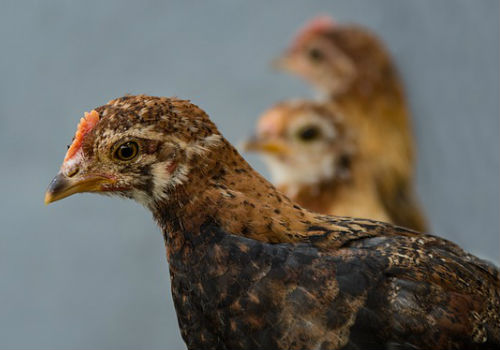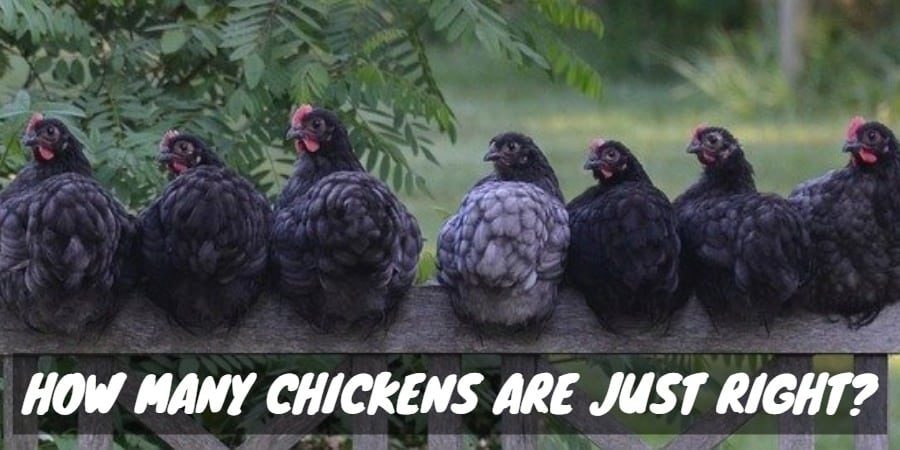Chickens vary in size depending on breed, age and gender. The average adult chicken weighs between 5 and 10 pounds. Roosters are usually larger than hens, and egg-laying chicken breeds are usually smaller than meat or mixed type breeds.
Chickens often appear larger than they are thanks to their feathers. A broody hen may fluff out her feathers even more than usual to appear large and intimidating. You may be surprised at how light a bird is to pick up after seeing it in motion.
[amazon bestseller=”chicken feed”]
Roosters being larger than hens is an example of sexual dimorphism. The rooster’s comb and long tail feathers are other dimorphic traits. A rooster’s size helps him to protect a flock against predators and other threats, so this dimorphism served the ancestors of chickens well in the wild.

It takes about a year for a chicken to reach full size. Under this age, hens are called “pullets” and males are called “cockerels.” Chickens raised for meat are usually slaughtered at this age as the meat has a more tender texture and milder flavor than an older bird. A fryer, or meat chicken, will usually weigh 4.5 to 5 pounds at slaughter. Depending on the breed, this could be quite a bit smaller than the chicken’s natural full size. However, fryers do tend to grow at a faster rate than other chicken breeds.
Meat-type chicken breeds are bigger than egg-type breeds because they are bred specifically to have a lot of muscle. The breast area is especially important due to the popularity of chicken breast meat. These large, muscular birds are also especially poor flyers.
Because most backyard chicken owners keep their birds for eggs rather than meat production, popular chicken breeds for hobbyists tend to be smaller than those raised for commercial chicken farms.
What Are the Largest Chicken Breeds?
The largest chicken breeds include the Jersey Giant, Brahma, Cochin, and Orpington. All of these birds average between 8 and 10 pounds in weight. They are also primarily known for being docile and easy to handle. Orpingtons are especially popular multi-purpose chickens that can be used for both meat and egg production.
Other large dual-purpose or egg-laying chicken breeds you may encounter are the Rhode Island Red, Rock and Wyandotte chickens. These breeds all average between 6 and 8 pounds in weight.

What Are the Smallest Chicken Breeds in the World?
Some of the smaller popular chicken breeds include the Leghorn, Polish and Game Hen. All of these breeds have hens that tend to weigh less than 5 pounds and roosters averaging about 6 pounds in weight.
However, you can get much smaller birds by raising bantams. A bantam chicken is essentially a miniature chicken, and many breeds come in both standard and bantam varieties. For example, an Ameraucana hen might weigh 5.5 pounds, but a bantam Ameraucana might weigh as little as 1.6 pounds. Most bantam breeds weigh under 2 pounds.
Some bantam breeds do not have full-size or “large fowl” equivalents. These chicken breeds are all very small in stature and are called “true bantams” as there are no full-size varieties. The smallest of these chicken breeds is the Serama, a Malaysian bird bred from other Asian bantam stock. These birds weigh just 500 grams and are primarily kept as pets. Other popular “true bantam” breeds include the Seabright, Pekin and Rosecomb chicken.
Bantam chickens obviously aren’t good for meat production, but they can be used for laying eggs. Bantam chicken eggs are smaller than regular eggs, but they are just as nutritious and taste the same as the eggs laid by larger hens. Bantams are also known for being broody, which can make them hard to keep for egg-laying.
Why Are Bantam Chickens so Small?

Bantam chickens display a type of dwarfism that is responsible for small size. This trait is sex-linked, which is useful for breeding because it helps to control the outcome. Breeding a bantam hen with a full-size rooster will result in full-size offspring.
[amazon bestseller=”chicken plush toy”]
Knowing this, some chicken farmers save on costs by raising bantam hens and breeding them with regular roosters for chicks that can be sold as fryers. That keeps space needs and feeding costs low while still allowing for full-size meat chicken production. However, the small eggs laid by bantam hens can cause problems for the growing chicks, so there is some risk associated with that technique.





Awesome facts about chickens I never knew before!!